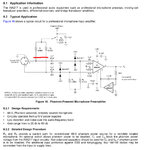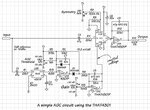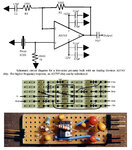allison_r
Newbie level 4

Hello,
I'd like to build a few mic preamps for my field recordings which usually involve low background noise and low sound levels, I can solder by following circuit drawings however I am not able to design them.
I thought I'd benefit from using a low noise high gain preamp with AGC and a switchable variable resistor to manually set gain those times I won't need AGC.
Since I'd leave equipment out in the wild for a few days (everything would be weather/waterproofed and weather forecasts studied to avoid noisy days such as rainy and windy ones, but those are obviously the least problem) and come back just to retrieve recorded data.
I thought that AGC, even with its obvious limitations, would be more useful to maximize sounds capture rather than setting a certain gain while on the field and leaving it at that level, potentially clipping sound sources coming closer and/or having many ones unrecorded due to too low of a gain set.
The switchable manual gain would come handy when I would record in more forecastable situations, so that I don't have to build another similar circuit over just to include a single function.
I'd couple each one of them (unless there is a fits-all circuit, which I'd gladly use) with a different input (a ceramic piezo transducer for water sounds and either an electret array or RF-condenser mic, due to its higher reliability in high ambient humidity, for air sounds).
Here is a conceptual diagram I sketched (recorders would be portable battery powered ones, I currently have two, both with 3.5mm TRS jack mic input, 1 with 1.6 kohm impedance and another with 2 kohm impedance, unless I upgrade to something else):

After looking for a good preamp I came across this one on a TI's datasheet which apparently has very good reputation (I did add the red line since I thought I won't need phantom power for my current project):

I have been suggested this AGC circuit (from a THAT datasheet):

However I am far from knowing how I should merge them.
Could you please help me? Any suggestion is welcome.
Thank you
Allison
I'd like to build a few mic preamps for my field recordings which usually involve low background noise and low sound levels, I can solder by following circuit drawings however I am not able to design them.
I thought I'd benefit from using a low noise high gain preamp with AGC and a switchable variable resistor to manually set gain those times I won't need AGC.
Since I'd leave equipment out in the wild for a few days (everything would be weather/waterproofed and weather forecasts studied to avoid noisy days such as rainy and windy ones, but those are obviously the least problem) and come back just to retrieve recorded data.
I thought that AGC, even with its obvious limitations, would be more useful to maximize sounds capture rather than setting a certain gain while on the field and leaving it at that level, potentially clipping sound sources coming closer and/or having many ones unrecorded due to too low of a gain set.
The switchable manual gain would come handy when I would record in more forecastable situations, so that I don't have to build another similar circuit over just to include a single function.
I'd couple each one of them (unless there is a fits-all circuit, which I'd gladly use) with a different input (a ceramic piezo transducer for water sounds and either an electret array or RF-condenser mic, due to its higher reliability in high ambient humidity, for air sounds).
Here is a conceptual diagram I sketched (recorders would be portable battery powered ones, I currently have two, both with 3.5mm TRS jack mic input, 1 with 1.6 kohm impedance and another with 2 kohm impedance, unless I upgrade to something else):

After looking for a good preamp I came across this one on a TI's datasheet which apparently has very good reputation (I did add the red line since I thought I won't need phantom power for my current project):

I have been suggested this AGC circuit (from a THAT datasheet):

However I am far from knowing how I should merge them.
Could you please help me? Any suggestion is welcome.
Thank you
Allison



